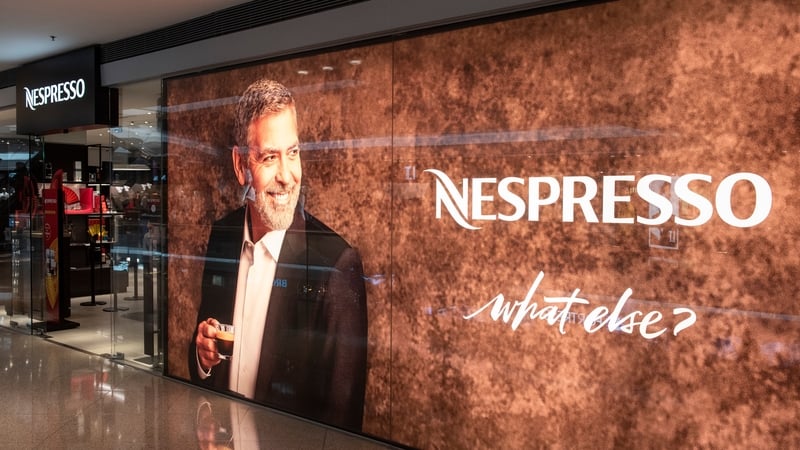When US President Donald Trump last week announced plans for a 39% tariff on Swiss imports, he blindsided politicians in the picturesque European state.
Swiss officials were reportedly convinced they had secured a 10% rate – but in the end were faced with a tariff that was higher even than the 31% rate proposed on ‘Liberation Day’ in April.
And one of the companies likely to bear the brunt of that stinging rate is consumer goods behemoth Nestlé – particularly via its premium coffee pod brand Nespresso.
That is actually the underdog in the US coffee pod market – trailing the dominant Keurig system. But it’s rapidly gaining ground.
In 2013 Nespresso had a 3% market share in the US; but by 2023 that had risen to more than 14%.
But the prospect of tariff-induced price rises could stifle that growth – which would represent a rare blip in what has been the remarkable growth of the coffee pod brand.
Though the story of Nespresso probably starts a lot earlier than you realise.
How so?
We need your consent to load this rte-player contentWe use rte-player to manage extra content that can set cookies on your device and collect data about your activity. Please review their details and accept them to load the content.Manage Preferences
Most people would think of a Nespresso machine as a very 21st century appliance – but the system was actually invented in 1975 and patented by Nestlé in 1976.
However it was too complicated and cumbersome to be economically viable for at least a decade – with the first commercial units not being launched until the mid-to-late 1980s.
And when they did arrive, they looked almost identical to regular espresso machines – down to having a portafilter where the pods went in. And Nespresso remained a fairly niche product through to the mid-to-late 90s, at which point things began to change.
One of the important factors behind that shift was the fact that Nestlé began to sign deals with appliance makers like Siemens, Philips and De’Longhi, which started to make Nespresso machines of their own.
That made them more accessible and affordable (and ultimately smaller and more countertop-friendly, too).
In the early 2000s, Nestlé also started opening retail outlets – and really it’s at this point that the concept took off.
And it’s become a huge success since then…

Massive – it’s hard to find figures on this but there are certainly tens, if not hundreds of millions of Nespresso machines in use around the world today.
It dominates the coffee pod market in Europe – even though there are alternatives like Tassimo (which is made by JDE Peet’s) and Dolce Gusto (confusingly, made by Nestlé). While it is also enjoying rapid growth in the US and other markets.
As a result, there’s huge demand for pods. There was a figure from 2020 which claimed Nestlé sold 14 billion pods a year – and it’s probably even higher now. That’s reflected in the fact that Nespresso had revenues of the equivalent of €3.4 billion in the first half of this year.
But that 14 billion pod sales figure doesn’t even properly reflect the popularity of the system. Because, given that it was invented in the mid-70s, Nestlé’s patents on the system actually began expiring in 2012 – just as it was properly reaching mainstream appeal.
That ultimately meant that other companies could start making and selling Nespresso-compatible pods and machines without needing approval from Nestlé, or without having to pay them a licencing fee.
Nestlé did try to fight that in the courts for a while but lost – which is why you can see a range of non-Nestlé pods in supermarkets today. The only thing companies have to be careful about is not giving consumers the impression that they’re official pods – which is why it can often be so hard to find the words ‘Nespresso-compatible’ on the packaging.
But ultimately that array of third party options means that there are likely billions more pods being sold each year – across a range of other coffee brands – on top of what Nestlé sell directly.
In a way the Nespresso has become the 21st Century’s Maxwell House – because it’s now the baseline for an at-home coffee.
If you go to a friend’s house and they offer you a coffee – even if they’re not enough of a coffee drinker to have an expensive espresso machine or a bag of fresh coffee – there’s a good chance that they’ll have a Nespresso machine, instead of a crusty jar of instant. The same goes for hotels – in a lot of places the Nespresso machine has replaced the bundle of instant coffee sachets stacked next to the kettle.
How has it managed to become so ubiquitous?

Part of the success has been down to their use of what you might call the ‘razor blade’ or ‘printer ink’ approach to sales.
Because Nestlé made a decision relatively early on to keep the price of the machines low in order to make them accessible to consumers – focusing on the pods as a way of making profit. The logic here being that if you make it easy for a customer to buy into your ecosystem, it will take a lot for them to decide to leave.
Though, now that customers can easily buy non-Nestlé pods, that model has become less lucrative. And that’s part of the reason why in 2014 – just two years after their patents started to expire – Nestlé brought out a new version of Nespresso.
Called the ‘Vertuo’ system, it uses bigger, dome-shaped pods – and the machine spins them, claiming the centrifugal force helps get better flavour extraction.
Many coffee experts have dismissed the value of this technique, but it is unique enough to allow Nestlé to patent it. That means no-one else can make pods to fit this system, so consumers have to go to Nestlé for their coffee (for the next four or five years at least).
And that, in turn, is part of the reason why you can often buy a technically newer Vertuo-compatible machine for less than one that fits the old-style pods. There’s now less of an incentive on Nestlé to subsidise the old pod system.
But aside from making machines affordable, another crucial thing that Nestlé did in building the Nespresso brand was to go up-market.
Rather than liken itself to instant coffee, Nestlé pitched Nespresso as a machine that could give users café-quality coffee in the home. And by doing this it justified charging much more per-drink.
A single Nespresso pod might cost you somewhere in the region of 50-60c, for example, which is a lot when you compare it to the 8-12c per serving you’d likely get from a jar of instant. But if, in your mind, you’re comparing it to the €4-5 coffee you get in your local café, then that 50c seems like a total bargain.
And it didn’t do them any harm to have George Clooney either…

Not at all. He initially came on board in 2006, at first as the face of the brand in Europe. In 2015 the deal was extended to cover the US market too.
And he’s been credited as a key driving force in helping Nespresso to rapidly gain ground in the US (the fact that the Vertuo machine can make larger coffees has also helped).
Needless to say, Clooney has done well from the deal too – he’s reportedly paid $40m. Although it’s not clear over what time-frame that is. In the 19 years of his relationship with Nestlé, he’s sure to have earned a lot more.
And that – along with some of his other business deals, like the sale of his tequila brand to Diageo, has meant that he is continually one of the world’s highest paid actors – even in years that he hasn’t actually made any films.
For his part, he’s previously said that the money from the Nespresso ads has gone towards funding a spy satellite that’s monitoring human rights abuses on the Sudan and South Sudan border. Though it’s been more than a decade since he said that, so it’s not clear if it’s still the case.
Either way it has shielded him somewhat from the criticism that Nespresso and Nestlé in general has faced.
These pods, while popular, are very controversial too…

Absolutely, and that’s aside from the string of controversies that Nestlé has been linked to over the years.
When it comes to Nespresso in particular, there has been evidence of child labour found at coffee farms used by the brand as recently as 2020. That is an issue the company has repeatedly pledged to tackle.
There is also the environmental impact of the system, because the pods are of course creating packaging that just didn’t exist in coffee making before.
Each Nespresso pod is encased in roughly one gram of aluminium, some other companies might use other materials, but aluminium tends to be the most popular, even with third parties.
And while a gram of packaging might not seem like a lot, across 14 billion pods you’re looking at 14,000 tonnes of packaging being created from official Nespresso-branded pods alone.
Aluminium is recyclable and the grounds inside are biodegradable, but most people are not going to take the time to cut the pods open, clean them out and dispose of them properly. That kind of undermines the convenience that makes the pods so attractive to people.
In response to this issue Nespresso has set up a recycling return programme, where customers get an empty packet they can put their used pods in and then post them to Nestlé to be disposed of properly.
But by Nespresso’s own admission, just one third of the pods it sells are getting returned, and that of course does not include the waste created by the pods made by other brands.
Some customers also argue that the scheme is impractical, because it takes time to fill each bag, in which time the pods begin to get mouldy and smelly.
So in reality, for most people, their pods just go in the bin, unlike a more traditional espresso, where the used coffee might go in the compost bin.
Although there is an interesting counter-argument on Nespresso’s environmental impact. This suggests that they could actually be better for the environment than a coffee made in an espresso machine or moka pot or cafetiere.
The argument points out that the biggest source of emissions in coffee is from the growing, harvesting, roasting and transportation of the beans, not the packaging. And when consumers use ground coffee they may end up putting too much in, or making a bigger pot than they need, leading to them throwing some of it out.
As a result, their per-cup footprint is bigger than it should be, unlike a Nespresso pod, which uses a precise amount of coffee per pod (and it’s actually slightly less than you’d use in a single shot of regular espresso, another way Nestlé squeezes out extra value).
But even with that in mind, it’s hard to look past the fact that these bits of aluminium weren’t part of the coffee-making process 20 or 30 years ago, but now they are, and the majority of that ends up going in the bin.
In general, what’s happening to coffee prices?

There were warnings earlier this year that the already high price for a cup of coffee in a café was going to rise further towards the end of the year.
That was based on a dramatic rise in the price of coffee on commodity markets, though it has eased off considerably since April.
There are a range of factors behind that, for example climate change is impacting harvest yields in the likes of Brazil and India, where most of our coffee comes from.
There have also been rising wages and rising transportation costs throughout the global supply chain.
But while the price of beans is being impacted by very real things like poor harvests and rising costs, it’s also being impacted by markets.
Coffee is traded a commodity, and traders will make bets on where they think the price will go, and their bets can in turn push up the price that’s paid in the real world.
Last month the CEO of Italian coffee company Lavazza suggested that hedge funds were to blame for 80% of the price increases that had been seen in the price of coffee over the past four years.




